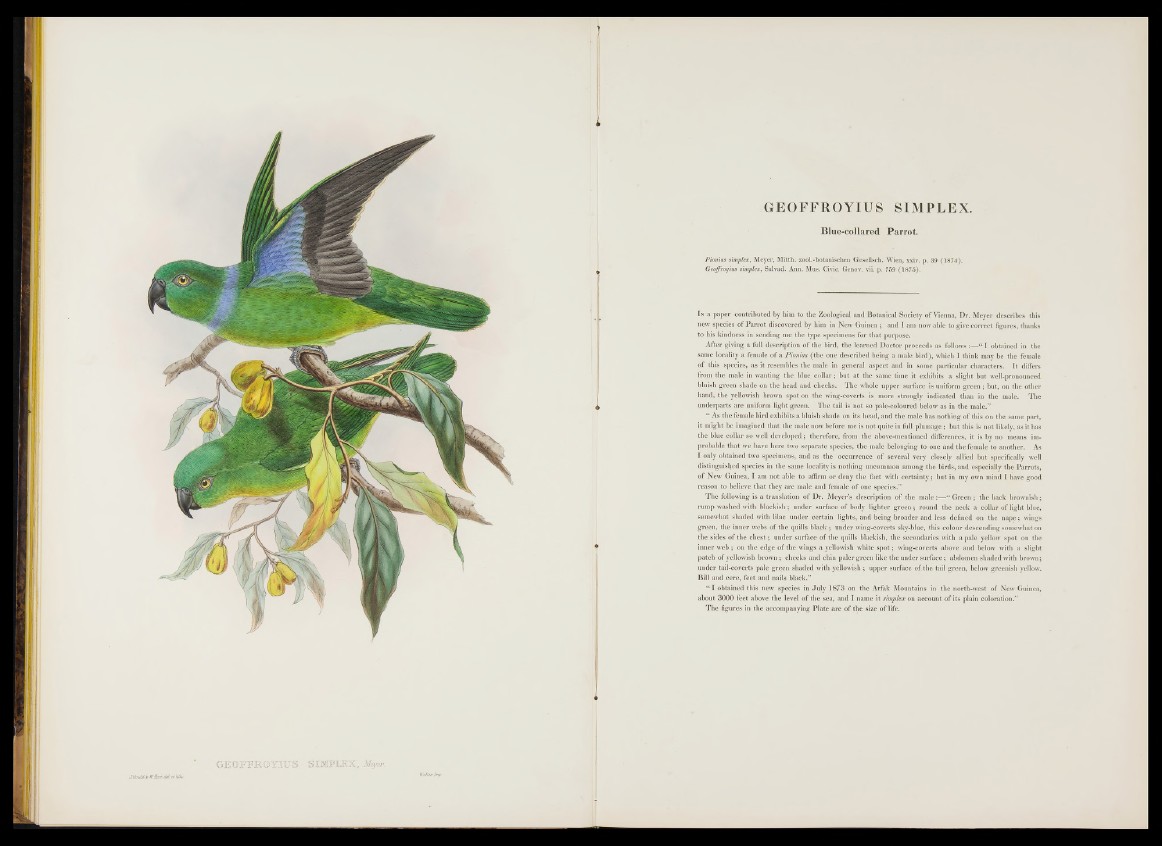
GEOFFROYIUS SIMPLEX.
Blue-collared P a rro t
Pionias simplex, Meyer, Mitth. zool.-botanischen Gesellsch. Wien, xxiv. p. 39 (1874).
Geoffroyius simplex, Salvad. Ann. Mus. Civic. Genov, vii. p. 759 (1875).
I n a paper contributed by him to the Zoological and Botanical Society o f Vienna, Dr. Meyer describes this
new species o f Pa rro t discovered by him in New Guinea ; and I am now able to give correct figures, thanks
to his kindness in sending me the type specimens for th at purpose.
After giving a full description o f the bird, the learned Doctor proceeds as follows :— “ I obtained in the
same locality a female o f a Pionias (th e one described being a male bird), which I think may be the female
o f this species, as it resembles the male in general aspect and in some particular characters. I t differs
from the male in wanting the blue c o lla r; but a t the same time it exhibits a slight but well-pronounced
bluish green shade on the head and cheeks. The whole upper surface is uniform g r e e n ; hut, on the other
hand, the yellowish brown spot on the wing-coverts is more strongly indicated than in the male. The
underparts are uniform light green. T h e tail is not so pale-coloured below as in the male.”
“ As the female bird exhibits a bluish shade on its head, and the male has nothing o f this on the same part,
it might be imagined th at the male now before me is not quite in full plumage; but this is not likely, as it has
the blue collar so well developed; therefore, from the above-mentioned differences, it is by no means improbable
th at we have here two separate species, the male belonging to one and the female to another. As
I only obtained two specimens, and as the occurrence o f several very closely allied but specifically well
distinguished species in the same locality is nothing uncommon among the birds, and especially the Parrots,
o f New Guinea, I am not able to affirm o r deny the fact with certainty; but in my own mind I have good
reason to believe that they a re male and female o f one species.”
T h e following is a translation o f Dr. Meyer’s description o f the m a le :— “ Green ; the back brownish ;
rump washed with blackish; under surface o f body lighter g re e n ; round the neck a collar o f light blue,
somewhat shaded with lilac under certain lights, and being broader and less defined on the n a p e ; wings
green, the inner webs o f the quills black ; under wing-coverts sky-blue, this colour descending somewhat on
the sides o f the c h e s t; under surface o f the quills blackish, the secondaries with a pale yellow spot on the
inner w e b ; on the edge o f the wings a yellowish white s p o t; wing-coverts above and below with a slight
patch o f yellowish brown ; cheeks and chin paler green like the under su rface; abdomen shaded with brown;
under tail-coverts pale green shaded with yellowish ; upper surface of. the tail green, below greenish yellow.
Bill and cere, feet and nails black.”
“ I obtained this.new species in Ju ly 1873 on the Arfak Mountains in the north-west o f New Guinea,
about 3000 feet above the level o f the sea, and I name it simplex on account o f its plain coloration.”
The figures in the accompanying Plate are o f the size o f life.